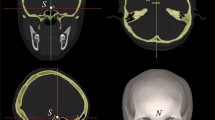Abstract
Background
Aging of the midface is complex and poorly understood. Changes occur not only in the facial soft tissues, but also in the underlying bony structure. Computed tomography (CT) imaging was used for investigating characteristics of the bony orbit and the anterior wall of the maxilla in patients of different ages and genders.
Methods
Facial CT scans were performed for 62 patients ranging in age from 21 to 70 years, who were divided into three age groups: 21–30 years, 41–50 years, and 61–70 years. Patients also were grouped by gender. The lengths of the orbital roof and floor and the angle of the anterior wall of the maxilla were recorded on parasagittal images through the midline of the orbit for each patient.
Results
The lengths of the orbital roof and floor at their midpoints showed no significant differences between the age groups. When grouped by gender, the lengths were found to be statistically longer for males than for females. The angle between the anterior maxillary wall and the orbital floor was found to have a statistically significant decrease with advancing age among both sexes.
Conclusion
Bony changes occur in the skeleton of the midcheek with advancing age for both males and females. The anterior maxillary wall retrudes in relation to the bony orbit, which maintains a fixed anteroposterior dimension at its midpoint. These changes should be considered in addressing the aging midface.


Similar content being viewed by others
References
Bartlett SP, Grossman RG, Whitaker LA: Age-related changes of the craniofacial skeletal: An Anthropomorphic and histologic analysis. Plast Reconstr Surg 90:592, 1992
Enlow DH: The human face. Harper and Row: New York, 1968
Flowers RS: Tear trough implants for correction of tear trough deformity. Clin Plast Surg 20:403, 1993
Gregory WK: Our face from fish to man. Putnam: New York, 1929
Jelks GW, Jelks EB: Preoperative evaluation of the blepharoplasty patient: Bypassing the pitfalls. Clin Plast Surg 20:213, 1993
Pessa JE: An algorithm of facial aging: Verification of Lambros’s theory by three-dimensional stereolithography, with reference to the pathogenesis of midfacial aging, scleral show, and the lateral suborbital trough deformity. Plast Reconstr Surg 106:479–488, 2000 discussion 489–490
Pessa JE, Chen Y: Curve analysis of the aging orbital aperture. Plast Reconstr Surg 109:751–755, 2002 discussion 756–760
Pessa JE, Desvigne LD, Lambros VS, Nimerick J, Sugunan B, Zadoo VP: Changes in ocular globe-to-orbital rim position with age: Implications for aesthetic blepharoplasty of the lower eyelids. Aesth Plast Surg 23:337–342, 1999
Pessa JE, Zadoo VP, Mutimer KL, Haffner C, Yuan C, DeWitt AL, Garza JR: Relative maxillary retrusion as a natural consequence of aging: Combining skeletal and soft tissue changes into an integrated model of midfacial aging. Plast Reconstr Surg 102:205–212, 1998
Pessa JE, Zadoo VP, Yuan C, Ayedelotte JD, Cuellar FJ, Cochran CS, Mutimer KL, Garza JR: Concertina effect and facial aging: Nonlinear aspects of youthfulness and skeletal remodeling, and why, perhaps, infants have jowls. Plast Reconstr Surg 103:635–644, 1999
Shaw RB, Kahn DM: Aging of the midface bony elements: A three-dimensional CT study. Plast Reconstr Surg 116(Suppl):12–14, 2005
Sutton DN, Lewis BRK, Patel M, Cawood JI: Changes in facial form relative to progressive atrophy of the edentulous patients. Int J Oral Maxillofac Surg 33:676–682, 2004
Yaremchuk MJ: Infraorbital rim augmentation. Plast Reconstr Surg 107:1585, 2001
Zadoo VP, Pessa JE: Biological arches and changes to the curvilinear form of the aging maxilla. Plast Reconstr Surg 106:460–466, discussion 467–468, 2000
Acknowledgment
The authors acknowledge Dr. Joel Pessa for his thoughts on the conceptualization of a study comparing the aging changes in the orbital floor with those in the orbital roof.
Author information
Authors and Affiliations
Corresponding author
Rights and permissions
About this article
Cite this article
Mendelson, B.C., Hartley, W., Scott, M. et al. Age-Related Changes of the Orbit and Midcheek and the Implications for Facial Rejuvenation. Aesth Plast Surg 31, 419–423 (2007). https://doi.org/10.1007/s00266-006-0120-x
Published:
Issue Date:
DOI: https://doi.org/10.1007/s00266-006-0120-x




